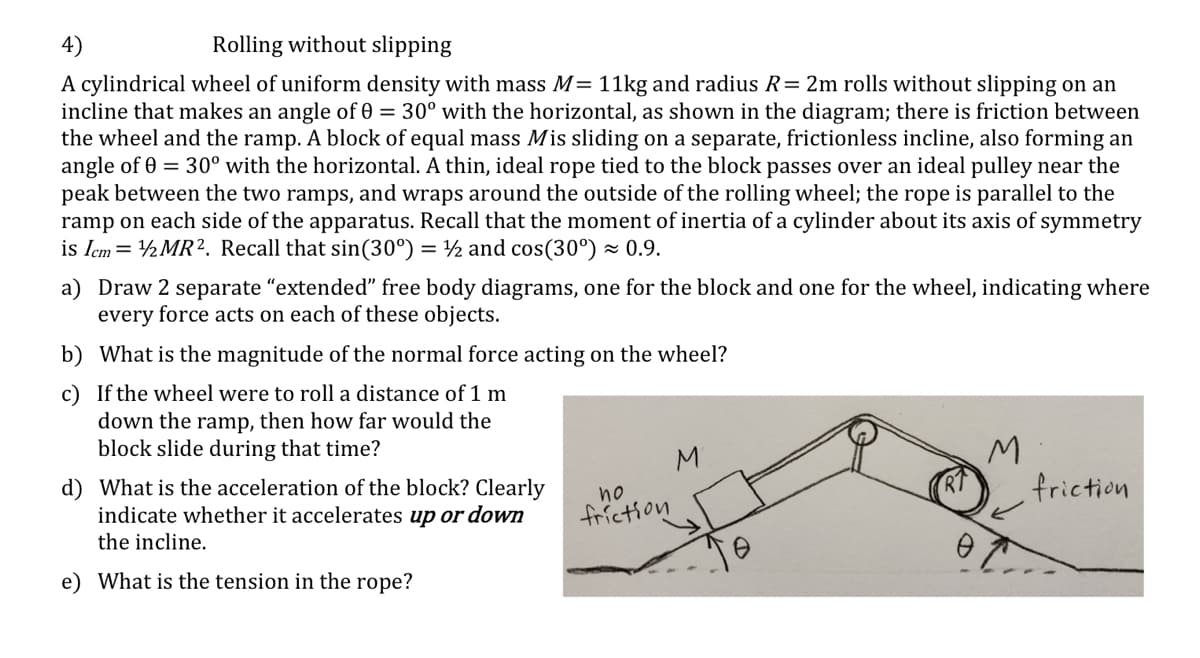4) Rolling without slipping A cylindrical wheel of uniform density with mass M= 11kg and radius R= 2m rolls without slipping on an incline that makes an angle of 0 = 30° with the horizontal, as shown in the diagram; there is friction between the wheel and the ramp. A block of equal mass Mis sliding on a separate, frictionless incline, also forming an angle of 0 = 30° with the horizontal. A thin, ideal rope tied to the block passes over an ideal pulley near the peak between the two ramps, and wraps around the outside of the rolling wheel; the rope is parallel to the ramp on each side of the apparatus. Recall that the moment of inertia of a cylinder about its axis of symmetry is Iem = 2MR2. Recall that sin(30°) = 2 and cos(30°) 0.9. a) Draw 2 separate "extended" free body diagrams, one for the block and one for the wheel, indicating where every force acts on each of these objects. b) What is the magnitude of the normal force acting on the wheel? c) If the wheel were to roll a distance of 1 m down the ramp, then how far would the block slide during that time? M. friction d) What is the acceleration of the block? Clearly indicate whether it accelerates up or down the incline. no friction e) What is the tension in the rope?
4) Rolling without slipping A cylindrical wheel of uniform density with mass M= 11kg and radius R= 2m rolls without slipping on an incline that makes an angle of 0 = 30° with the horizontal, as shown in the diagram; there is friction between the wheel and the ramp. A block of equal mass Mis sliding on a separate, frictionless incline, also forming an angle of 0 = 30° with the horizontal. A thin, ideal rope tied to the block passes over an ideal pulley near the peak between the two ramps, and wraps around the outside of the rolling wheel; the rope is parallel to the ramp on each side of the apparatus. Recall that the moment of inertia of a cylinder about its axis of symmetry is Iem = 2MR2. Recall that sin(30°) = 2 and cos(30°) 0.9. a) Draw 2 separate "extended" free body diagrams, one for the block and one for the wheel, indicating where every force acts on each of these objects. b) What is the magnitude of the normal force acting on the wheel? c) If the wheel were to roll a distance of 1 m down the ramp, then how far would the block slide during that time? M. friction d) What is the acceleration of the block? Clearly indicate whether it accelerates up or down the incline. no friction e) What is the tension in the rope?
College Physics
1st Edition
ISBN:9781938168000
Author:Paul Peter Urone, Roger Hinrichs
Publisher:Paul Peter Urone, Roger Hinrichs
Chapter10: Rotational Motion And Angular Momentum
Section: Chapter Questions
Problem 17PE: An automobile engine can produce 200 N m of torque. Calculate the angular acceleration produced if...
Related questions
Question
2020Q4: Please answer all parts in specific detail and explain each step with reasoning

Transcribed Image Text:4)
Rolling without slipping
A cylindrical wheel of uniform density with mass M= 11kg and radius R= 2m rolls without slipping on an
incline that makes an angle of 0 = 30° with the horizontal, as shown in the diagram; there is friction between
the wheel and the ramp. A block of equal mass Mis sliding on a separate, frictionless incline, also forming an
angle of 0 = 30° with the horizontal. A thin, ideal rope tied to the block passes over an ideal pulley near the
peak between the two ramps, and wraps around the outside of the rolling wheel; the rope is parallel to the
ramp on each side of the apparatus. Recall that the moment of inertia of a cylinder about its axis of symmetry
is Iem = ½MR2. Recall that sin(30°) = ½ and cos(30°) - 0.9.
a) Draw 2 separate "extended" free body diagrams, one for the block and one for the wheel, indicating where
every force acts on each of these objects.
b) What is the magnitude of the normal force acting on the wheel?
c) If the wheel were to roll a distance of 1 m
down the ramp, then how far would the
block slide during that time?
M.
friction
d) What is the acceleration of the block? Clearly
indicate whether it accelerates up or down
the incline.
no
friction
e) What is the tension in the rope?
Expert Solution
This question has been solved!
Explore an expertly crafted, step-by-step solution for a thorough understanding of key concepts.
Step by step
Solved in 3 steps with 3 images

Knowledge Booster
Learn more about
Need a deep-dive on the concept behind this application? Look no further. Learn more about this topic, physics and related others by exploring similar questions and additional content below.Recommended textbooks for you

College Physics
Physics
ISBN:
9781938168000
Author:
Paul Peter Urone, Roger Hinrichs
Publisher:
OpenStax College

University Physics Volume 1
Physics
ISBN:
9781938168277
Author:
William Moebs, Samuel J. Ling, Jeff Sanny
Publisher:
OpenStax - Rice University

Physics for Scientists and Engineers with Modern …
Physics
ISBN:
9781337553292
Author:
Raymond A. Serway, John W. Jewett
Publisher:
Cengage Learning

College Physics
Physics
ISBN:
9781938168000
Author:
Paul Peter Urone, Roger Hinrichs
Publisher:
OpenStax College

University Physics Volume 1
Physics
ISBN:
9781938168277
Author:
William Moebs, Samuel J. Ling, Jeff Sanny
Publisher:
OpenStax - Rice University

Physics for Scientists and Engineers with Modern …
Physics
ISBN:
9781337553292
Author:
Raymond A. Serway, John W. Jewett
Publisher:
Cengage Learning

Physics for Scientists and Engineers
Physics
ISBN:
9781337553278
Author:
Raymond A. Serway, John W. Jewett
Publisher:
Cengage Learning

College Physics
Physics
ISBN:
9781305952300
Author:
Raymond A. Serway, Chris Vuille
Publisher:
Cengage Learning

Physics for Scientists and Engineers: Foundations…
Physics
ISBN:
9781133939146
Author:
Katz, Debora M.
Publisher:
Cengage Learning